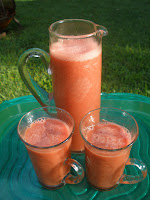
My dream kitchen would have a large fire place where I could hang my herbs and fruits from to dry. For now the dehydrator in the corner of my kitchen has been working non-stop all fall. I have been drying jalapeno peppers, stevia, apples and bananas not just to preserve them, they also make great snacks for school or long car rides as well as healthy gifts. I gave my dad a basked filled with dried fruits and nuts for his birthday, he love it. But the last load in the dehydrator was now for eating it is for decorating. I like to decorate my kitchen for the winter holidays with garlands made from dried apples, dried oranges, and fresh cranberries. I hang it over the entrance to the kitchen with a sprig of mistletoe in the middle. Here is how I do it...
take 2 apples and cut them in about 1/4" slices cross-way so that you will be able to see the star inside that is make by the seeds. Cut 2 oranges the same way so that you can see the sections. Put them into a dehydrator or a gas oven with just the pilot-light on for about two days or completely dried.
You will also need a bag of fresh cranberries, fishing line or heavy thread measured out to length you will need for area you will be hanging in, and a large sewing needle. Mark the center of the thread with a marker. Thread your needle and put a knot at the end.
When your apples and oranges are dried arrange them on a table in a pattern that you like knowing that you will be adding cranberries in between. Starting with a cranberry put your needle through the center from end to end. Do this again with the same cranberry to secure the end of your garland. Now you can continue adding cranberries until you are ready to add an apple or orange. Go on stringing the pattern of fruit adding cranberries between the apples and oranges until you get to the center mark of your thread. If you want your garland to be symmetrical just reverse what you have just done. When you get to the end of your garland take the needle through the last cranberry twice like you did in the beginning and knot. The cranberries will naturally start to dry and shrivel and they may leak some of their juice so be careful that it is not hanging against anything that could get stained. Now you are ready to hang your garland in a doorway, window, a fireplace, or on a tree and enjoy.
When you are done with your garland after the season has past take your fruits off the thread and put them outside for the animal to enjoy.
Happy Holidays!












.JPG)
.JPG)
.JPG)
